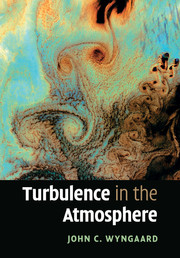Book contents
- Frontmatter
- Contents
- Preface
- Part I A grammar of turbulence
- 1 Introduction
- 2 Getting to know turbulence
- 3 Equations for averaged variables
- 4 Turbulent fluxes
- 5 Conservation equations for covariances
- 6 Large-eddy dynamics, the energy cascade, and large-eddy simulation
- 7 Kolmogorov scaling, its extensions, and two-dimensional turbulence
- Part II Turbulence in the atmospheric boundary layer
- Part III Statistical representation of turbulence
- Index
2 - Getting to know turbulence
from Part I - A grammar of turbulence
Published online by Cambridge University Press: 11 April 2011
- Frontmatter
- Contents
- Preface
- Part I A grammar of turbulence
- 1 Introduction
- 2 Getting to know turbulence
- 3 Equations for averaged variables
- 4 Turbulent fluxes
- 5 Conservation equations for covariances
- 6 Large-eddy dynamics, the energy cascade, and large-eddy simulation
- 7 Kolmogorov scaling, its extensions, and two-dimensional turbulence
- Part II Turbulence in the atmospheric boundary layer
- Part III Statistical representation of turbulence
- Index
Summary
Average and instantaneous properties contrasted
Figure 2.1 is a famous snapshot of a turbulent wake, the region downstream of a body in a moving fluid. The instantaneously thin, irregular boundary between the turbulent and nonturbulent flow is continuously deformed by the turbulent eddies, so that under averaging it becomes a broad, smooth transition region. Figure 2.2 illustrates this same feature at the top of the atmospheric boundary layer.
We have had access to instantaneous turbulence fields through remote sensing and numerical simulation only since the 1970s. Perhaps that is why our descriptive terms for turbulence tend to refer to its statistical properties, not its instantaneous ones. For example,
Homogeneous turbulence has spatially uniform statistical properties (with the exception of mean pressure). A turbulent flow can be homogeneous in zero, one, two, or three directions. A sphere wake is an example of the first. The turbulent boundary layer near the leading edge of a flat plate, or downstream of a change in surface conditions, can be homogeneous in one direction (the lateral) but is inhomogeneous in the wall-normal and streamwise directions. The turbulent boundary layer over a uniform surface can be homogeneous in two directions, those in the plane parallel to the surface, but is necessarily inhomogeneous in the normal direction. The grid turbulence produced by a grating of bars spanning the cross section of a wind tunnel is homogeneous in the cross-stream plane but inhomogeneous in the streamwise direction because it decays as it goes downstream (Chapter 5). […]
Information
- Type
- Chapter
- Information
- Turbulence in the Atmosphere , pp. 27 - 54Publisher: Cambridge University PressPrint publication year: 2010
Accessibility standard: Unknown
Why this information is here
This section outlines the accessibility features of this content - including support for screen readers, full keyboard navigation and high-contrast display options. This may not be relevant for you.Accessibility Information
- 1
- Cited by
